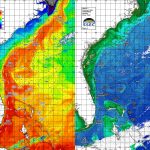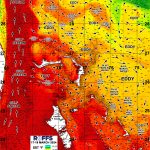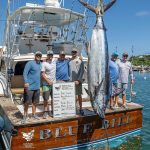28 AUG 2008 Northeast Region Special Analysis
(click above to download the analysis (PDF) and text)

There has been a substantial amount of talk on the docks and elsewhere about the lack of tuna in this region. Some have even considered that the yellowfin tuna have migrated south early this year. It is my experience that there is no reason for the fish to migrate early as the fish follow certain overall migration habits in relation the location and conditions of their preferred habitats. Most importantly is that fish, especially tuna follow certain preferred habitats of temperature, oxygen, salinity, clarity/turbidity and food abundance. Presently the conditions that exist now do not preclude the tuna from being in this area. However, as there is an abundance of warm, blue water in the region (78°F-81°F) from the Gulf Stream eddy (see enclosed ocean color image of the eddy today). There is an extensive area of this blue water from the canyons south of Long Island to Cape Hatteras. However, the surface temperature conditions indicate that the tuna are located substantially deeper in the water column and are feeding on an unusually abundant source of squid. When the fish are feeding deep in the water column they are less likely to swim to the surface to attack your trolled baits. The best tactic under the present conditions is to place your baits deep in the water column as if you were fishing for swordfish. We have heard reports that the thermocline (area where the water temperature rapidly declines) is located at a depth of 200-300 feet. While you have to determine this depth for your local area using your fathometers, you must change your fishing tactics to catch more fish. This means that if you are only interested in tuna, that you should probably stop trolling during the day and start chunking and placing live baits 50-100 feet below the thermocline and at the thermocline. If you have to troll you should find locations where the water is not as warm, e.g. 77°-78°F, with adequate water transparency (non-turbid conditions) to allow the fish to see your baits since the tunas are visual feeders. The blue water is pretty, but fish often feed along the color changes since they are ambush visual feeders. Color changes are important as visual cues and often they are indicators of the more important water mass boundaries which are zones where significant water density differences occur. These ocean frontal zones are where the convergent forces pull food particles (zooplankton and small fish) into a relatively narrow zone. If these zones stay in one location for three days, the larger fish usually find them and are concentrated themselves. To catch tuna tolling should also modify your trolling techniques to place your baits at depth by using high speed planers, weights before your swivel to the leader (as if you were wahoo fishing in the Bahamas and elsewhere), and down riggers. You will also have to find locations where the naturally occurring bait is concentrated, such as areas where the water mass boundaries have been coincident for three or more days and where the current is moving into the ledges. Flow away from ledges tend to disperse the natural bait fish, leaving the larger target species dispersed over a larger area. Based on the present oceanographic conditions in many areas, this means that you will have to troll over 30-40 fathom depths. Remember the days when the boats were not so big and fast? Successful fishermen used to catch tuna, dolphin and marlin in 20-50 fathom depths. Do not be overly discouraged, you will have to learn new techniques to catch fish under these conditions. This will take some time. ROFFS™ is here to help you. Safe and Successful Fishing,





